St. Thomas Aquinas Stained Glass
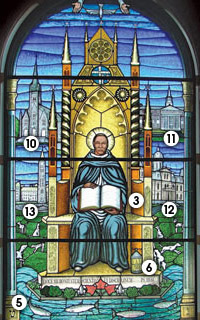
The stained glass window located in the Great Hall at St. Thomas University, Fredericton, N.B. Canada depicts the story of the University and its patron St. Thomas Aquinas (c. 1225-1274), who taught at the University of Paris and is seated ‘in cathedra’ (in the teacher’s chair).
The over arching theme of the window is the unity of knowledge to which the mission of a Catholic university is devoted and which is represented by our patron, St. Thomas Aquinas, the great medieval theologian, known as the ‘Angelic Doctor’. Through his commentaries on the Bible and the Philosopher, that is Aristotle, mediated to him through Muslim and Jewish thinkers, he offers a vision of Christian humanism grounded in reason and divine revelation.
Christ, Savior of humanity bestows his grace and doctrine. Sent forth by the Father, the Word became Flesh and dwelt among us. [Jn 1:14] The Word and Redeemer by His sacrifice on the cross has saved and redeemed humanity. The several crosses distributed throughout the window remind us of this sacrifice as well as of the mission and place of church in the world, in community; both academic and socio-political.
After the Ascension, this work of Christ began with the descent of the Holy Spirit on the Apostles and continues through the doctors of the Church particularly with St. Thomas Aquinas. The Father put all into Jesus’ hands. From these hands is sent forth the gift of the Holy Spirit after the baptism [Acts. 8:17]. Biblical and local historical representations are referenced in the presentation.
The narration begins from the height of the vaulted window. The hands of God send forth the Holy Spirit represented by the dove. In Catholic academies study and research often would begin with the petition of the community of scholars praying the words “Come Holy Spirit and fill the hearts of the faithful” – “Veni, Creator Spiritus”.
At the very top of the Magisterial Chair is a cross reminding that Jesus is the one teacher, the way, the light, the truth and the role of teaching in the mission of the Church.
1. St. Thomas and the blessed Virgin Mary
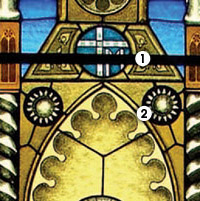
Below is situated a rosette rose window which speaks to the nativity and Jesus’ mother the Virgin Mary. The second reference to Mary is depicted in the roundel immediately below the rosette where we find drawn from the Papal Coat of Arms of Pope John- Paul II the cross and the letter “M”. This second symbol of Mary also situates the present stained glass window in the order of time as well as recalling the very special devotion which this long serving pontiff had to Mary the mother of God.
St. Thomas Aquinas and the Queen of Heaven have often been illustrated together in sacred art. The “polypitch” of Andrea Orcagna (1357) located in the Strozzi chapel of the Basilica of Santa Maria Novella, Florence, contains a rich scene representing Mary “Regina Caelorum” presenting to God the Son, the Angelic Doctor who with a book of his writings in hand, offers the same to the accepting right hand of God the Son. A further presentation of St. Thomas and the Mother of God is found in the Carafa Chapel of Santa Maria Sopra Minerva, Rome. This chapel was originally dedicated to the Annunciation and the Assumption in 1446 but subsequently was dedicated to St Thomas and the Annunciation as is indicated by the inscription on the external archway stating: “Divae Virgini Annunziatae et divo Thomas Aquinat – Sacrum”.
2. The Two Suns
The two suns illustrated over the head of St. Thomas are drawn from the official Coat of Arms of St. Thomas University. Her Majesty Queen Elizabeth II, in Letters Patent from the Chief Herald of Canada granted these arms to the university in 1997.
The suns symbolize the learning, or light of knowledge and the search for truth which is the mission of the academic community. The one representing the light of human reason as exercised by the probing mind seeking knowledge, much as is done by the philosophers. The second sun being symbolic of the intellect informed by the light of revelation, as is taken into account by the theologian who explores and seeks understanding of the Word of God through Scripture and Tradition with the aid of the Magisterium and human experience. In St. Thomas Aquinas philosophy and theology finds exemplary expression.
It is interesting for one to find three roundels located in a similar position in the Gothic throne of Andrea Buonaiuto located in the Florentine Spanish Chapel. In a roundel on the cusp of the throne is a half figure of a young man with a halo who is holding an open book in his right hand and a mirror in his left. These are symbolic of science and knowledge. In the place similar to the two suns in the St. Thomas University stained glass window, the Spanish chapel depiction has one roundel with the face of a youth expressing juvenile ardour of the student who studies with passion. The other is a representation of an older person reflecting the wisdom of experience and the role of the teacher to impart knowledge and wise counsel based on experience.
3. The Chair
St. Thomas, garbed in the black Dominican cape and white habit, is seated in the “magisterial” or “teacher’s” chair. This setting recalls the rich Gothic throne depicted in the fresco of the “Triumph of St. Thomas and the allegory of the liberal arts and sacred sciences” by Andrea di Buonaiuto (1367) found on the left wall of the Spanish Chapel in the Florentine Basilica of Santa Maria Novella.
Holding against his chest, the book of knowledge in which is written: “optavi et datus est mihi sensus et invocavi et venit in me spiritus sapientiae et prae posui illam requis et sedibus”.
“I prayed and was granted prudence;
I implored and the spirit of knowledge came unto me;
I preferred it to kingdoms and thrones”.
These words are found in the first reading for the Mass on the Feast of St. Thomas Aquinas. One can find other representations of the Angelic Doctor depicted with the book held opened such as in the Carafa Chapel of Santa Maria Sopra Minerva in Rome. Here in “The Triumph of St Thomas” by Filippino Lippi we see written on the pages: “sapientia sapientum perdam” “I will destroy the wisdom of the wise” [I Cor. 1, 19].
On each side of the back of the magisterial teacher’s chair is a spinal supporter recalling the pillars holding up the canopy over the High Altar in St. Peter’s Basilica, Rome. Bernini’s work on this canopy for the High Altar which is located over the tomb of St. Peter, symbolically ties the patron Saint of St. Thomas University and the university community to the See of Peter. This tie is foundational to the very ‘raison d’etre’ of St. Thomas University. It is therefore that the ‘cross’ in the university’s coat of arms is a ‘Latin Cross’ underscoring the Roman Catholic tradition and vocation of St. Thomas University.
4. The Hounds of Heaven
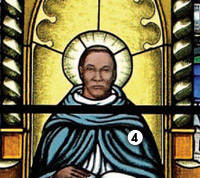
At first glance one might be surprised to see the Dalmatian dogs portrayed in the field near the base of the “cathedra”. However, the Dominican Friars who wore a white habit and black cloak were sometimes referred to as “Gods Watch Dogs” or “The Hounds of Heaven”. One also recalls that St. Dominic founded the Order to stamp out heresy.
It is instructive to note that the fresco on the right wall of the Spanish Chapel at Santa Maria Novella, Florence which depicts the “Allegory of the Active and Triumphant Church and of the Dominican Order”, contains a number of black and white Dalmatian dogs. These “domini canes” or “canes caelorum” are found with St. Dominic, St. Thomas and St. Peter Martyr. St. Dominic sends his set of hounds as if on a hunt against wolves or heretics to save lambs of God. St. Peter Martyr is seen disputing with the heretics where as St. Thomas Aquinas is portrayed presenting the heretics with the book of knowledge containing the Scriptural passage from Proverbs [8:7]: “For my mouth shall speak truth; and wickedness is an abomination to my lips.” These are the words found at the beginning of his work ‘Summa Contra Gentiles’. The dogs are generally frolicking being dogs, but the one in the left foreground is “on point” pointing to St Thomas.
BASE OF THE ‘CATHEDRA’
The “cathedra” sits on its solid base, full of symbols of the strong foundation of the church, university, province and country. At the base of the magisterial chair one finds the motto of St. Thomas University which comes from Psalm 118 verse 66:
“Teach me goodness, knowledge and discipline”
‘doce me bonitatem, scientiam et discipilnam’
This passage is drawn from the Davidic Psalm where the verses are grouped under various letters of the Hebrew alphabet. The Hebrew letter Teth, one of the two letters for “t” heads the passage at verse 66 from which the St Thomas University motto is drawn. The letters patent of the official Coat of Arms granted by the Her Majesty Queen Elizabeth II, through the Canadian Heraldic Authority at Rideau Hall, formally assigned this motto to the university. An additional important historical significance for these words, is that the exact same motto is embraced by the Basilian Fathers and St. Michael’s college at the University of Toronto. It was the Basilian Fathers who directed St. Thomas University in Chatham, N.B. from 1910until 1923. Indeed, prior to the arrival in Chatham of the Basilian Fathers, the name of the institution was St. Michaels Academy. This name was changed at that time to St. Thomas, in order to avoid any confusion with the St. Michaels College in Toronto, which was and continues to be under the direction of the Basilian Fathers. It is noteworthy that the official seal of St. Thomas University, incorporated in the university’s Coat-of-Arms granted by the Letters Patent, is of St. Michael the Archangel, the patron of the earlier named St. Michael’s Academy and the continuing St. Michael’s Basilica in Chatham, N.B., founding home of St. Thomas University.
5. The Archway
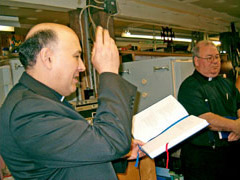
For the border arch framing the window the artist and glass workers chose as their model, the main portal of Santa Maria Novella, with the keystone being an element from the arch over the raised altar in the same Florentine church.
The footings on each side of the arch contain a letter from the Hebrew alphabet. On the viewers left is the letter “Teth”, whereas on the right is the Hebrew letter “Nun”. The former is one of the two letters for ‘t’ in the alphabet. Not only is the letter “Teth” heading Psalm 118 at paragraph 66 from where the university’s motto is drawn, but the letter “T” is symbolic for St. Thomas University. This letter has acquired a special importance for the academic community through such use as the “T”- Ring ceremony held annually on-campus. Many members of the St Thomas community proudly wear the T-Ring.
The base of the Arch Border on the viewer’s right contains the Hebrew letter “nun” or “N”. Under this letter is grouped in Psalm 118 the words at lines 105: “Thy word is a lamp to my feet and light to my paths.” The letter “n” is also a reference to Noel A, Kinsella, a member of the faculty of St Thomas University for more than four decades, and benefactor of this stained glass window.
6. The Lamp
It is significant that we find a lamp near the left foot of St. Thomas sitting in the “cathedra”. Significantly, the work of St. Thomas Aquinas, enlightened by the “Word” continues to illuminate themes of a theological and philosophical nature today. The “Word”, which guided Thomas, continues to show the way for all who follow His path.
The flame burning in the lamp is in the shape of the United Nation’s symbol for human rights. St Thomas University is an academic centre for study and action in the field of human rights. This work has been inspired by the social justice teaching of the Church including the remarkable Papal Encyclical “Pacem in Terris” of Blessed John XXIII as well as the writings of the Angelic Doctor. A close association is maintained with the Pontifical Council ‘Justitia et pax’.
7. The Flowers and Leaves
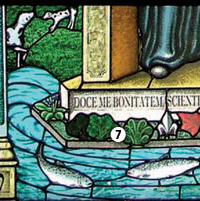
The floral and leaf representations on the platform under the Chair include shamrocks, violets and three maple leafs entwined, together with some fiddleheads.
The shamrocks in their natural green speak to the Irish community of New Brunswick which have been closely associated with St. Thomas University. Special reference can be given to the Irish on the Miramichi where the university was founded in the late 1800’s under the patronage of St. Michael the Archangel. It is noteworthy that the seal contained in the formal university Coat-of-Arms, is the representation of St. Michael the Archangel. In the upper left side of the Stained Glass Window is St. Michael’s Basilica in Chatham with a Celtic Cross.
St. Patrick’s use of the three leaf shamrock to illustrate the Mystery of the Three Persons in One God, the Holy Trinity is a long tradition within the church not only in Ireland but throughout the world.
The maple leaf entwined might prove to be another paradigm for approaching the Holy Trinity within the Canadian context. The place of St. Thomas University within the post-secondary education infrastructure of Canada might also be symbolized by the three Maple leads entwined.
The fiddleheads speak to the First Nations of Canada and in particularly the Micmac and the Maliseet people of New Brunswick. Students from these aboriginal communities have numbered among the student body of St. Thomas University for many generations. The faith and traditions of the noble Micmac and Maliseet has long been celebrated at St Thomas University.
The New Brunswick flower, the violet not only anchors St. Thomas University in the Province of New Brunswick but the purple colour of these beautiful flowers might well evoke the anticipation and preparation as we await the coming of the Lord celebrated liturgically in the seasons of Advent and Lent.
8. The Water and the Fish
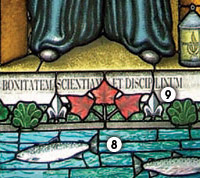
The water serves as a strong reminder that the story of St. Thomas University is a journey which entails sojourns along the banks of the two great rivers in the Province of New Brunswick; the Miramichi; and the St. John. Until 1963 St. Thomas University and its predecessor St. Michael’s Academy were located along the banks of the Miramichi. In 1964 the University opened its doors along the banks of the St. John River in Fredericton. The Chair being surrounded on three sides by the water is, like the seas which border the country, north, east and west.The Scriptures are full of references to water, from the Baptism of Jesus by St. John the Baptist in the waters of the Jordan River [Mt 3:16] to Jesus walking on the water [Mt 3:26]. For St. Thomas Aquinas, as for members of the academic community, the desire to quench one’s thirst for knowledge comes as an invitation in the New Testament:
“come forward, you who are thirsty,
accept the water of life,
a free gift to all who desire it” [Rev. 22:17]
The salmon of the Miramichi River also situate St. Thomas University and its history in New Brunswick. However, one can note that the first Christians spontaneously represented Christ by the symbol of the fish. It is of interest that the book of Genesis provides that from the beginning we were to “have dominion over the fish of the sea” [Gen 1:28]
The fish recall the miracle of the loaves and fish [Mt 15:36] and the mandate to be fishers of people [Jn 21:3] and to love and care for them [Jn 21: 15-17].
9. The 'Fleurs de Lis'
The important symbol of the ‘fleur de lis’ finds many expressions in the Scriptures. Within the setting context of St. Thomas University it speaks to the Francophone Community of New Brunswick and Canada and the association with the university of so many francophone students, faculty, administration and Board Members over the years.
The Institutions
10. The St. Michaels Basilica reflected in the upper left quadrant of the background is recognition of the origin of St. Thomas University as St. Michael’s Academy. The priests who served at St. Michael’s Basilica were often teachers at the college. The story of St. Thomas University could not be told without reference to this house of God and dedicated work of the many priests who were models of knowledge, goodness and discipline.
11. George Martin Hall on the Fredericton campus of St. Thomas University is represented in the upper right background. This building is the most notable signature of the university campus. The steeple over the building situates the university chapel which is the epic centre of life at a Catholic university.
This building is named in honour of Msgr. George W. Martin, a priest-educator who dedicated his life to St. Thomas University, including a series of terms as its President. The wisdom, analytic mind, and piety of this good priest is an inspiration to the St. Thomas community. For some the image of the face of the Angelic Doctor in the stained glass window might suggest to some a visual similarity to Msgr. Martin.
12. The Legislative Building of New Brunswick symbolizes the support which the university has received from the people of New Brunswick and the mutual respect existing between the University and the Government. The writings of St. Thomas are instructional in areas such as: the nature of law, “lex”, “ius”, the common good, and legitimate authority. [Summa I-II q.90]
13. The Parliament Buildings in the national capital underscore the national mission of St. Thomas University and the fact that many members of the St. Thomas community have played key roles in Parliament shaped by their St. Thomas experience. Numbering amongst this group include a Prime Minister, a Speaker of the Senate, Ministers of the Crown, Members of Parliament, Senators, Diplomats and public servants.
The political philosophy of St. Thomas Aquinas and his analysis of the nature of society and the commonweal finds expression in the practical world of nation building and good governance.
For all these gifts and for our benefactors we give you thanks O Lord and so we pray with Thomas Aquinas …
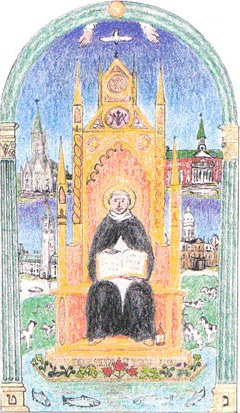
A Student’s Prayer
Creator of all things,
true source of light and wisdom,
origin of all being,
graciously let a ray of light penetrate
the darkness of my understanding.
Take from me the double darkness
in which I have been born,
an obscurity of sin and ignorance.
Give me a keen understanding,
a retentive memory, and
the ability to grasp things
correctly and fundamentally.
Grant me the talent
of being exact in my explanations
and the ability to express myself
with thoroughness and charm.
Point out the beginning,
direct the progress
And help in the completion.
I ask this through Christ our Lord. Amen.
The Artist and The Craftsman
Artist H. Hugh MacKinnon and Master Craftsman Edward (Ned) Bowes collaborated in the creation of the stained glass window at their “Shades of Light” workshop located in Fredericton, New Brunswick. The two have had a special relation with St Thomas University.
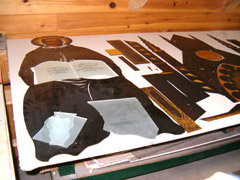
Hugh MacKinnon was born and raised in Fredericton where he received early formal training in art from the public school system and more particularly at York Street School under Mr. Clive Roberts. Since grade school his art education was largely self-taught through reading and practice. He has always admired the stained glass windows while in church, but it was at university that he developed a love of early Christian art. Hugh was greatly influenced by two series of courses during his university years – Art History from Stuart Smith at the University of New Brunswick and Russian History from Tony Rhinelander at St Thomas University. An epiphany occurred while viewing slides of Ravenna where, in the fifth and sixth centuries, the Emperor Justinian had built lovely Byzantine edifices and filled them with colourful mosaics. The Mausoleum of Galliplacidia was the first building that Hugh knew that he must visit. His art experience grew through many visits to European churches, museums and galleries.
Ned Bowes is a son of the Miramichi having grown up on the shores of this great New Brunswick river. His early education and work experience were in this area. He studied at St Thomas University from where he received the Bachelor of Arts degree in 1972. Having worked in the far north of Canada, the experience of light in this setting including the northern lights contributed to his interest in the stained glass. He began an apprenticeship in this art form with English artist Robert Hunt. Subsequently he opened his own studio called “The Light House” in Calgary, Alberta.
Teaching at studios in Calgary and later studying with Maurice Lorriaux Ned went on to apprentice under Marc Chagall in Santa Fe, New Mexico. Subsequently Ned obtained the degree of “Maitre D’ vitraux” from the American Stained Glass Institute. Over the years he has gained experience through travel studying the masters in Europe and Mexico.